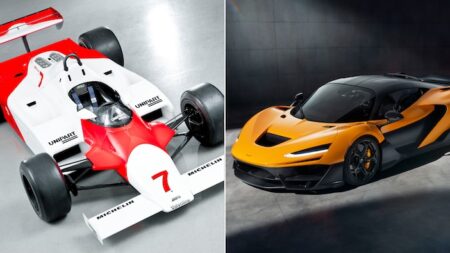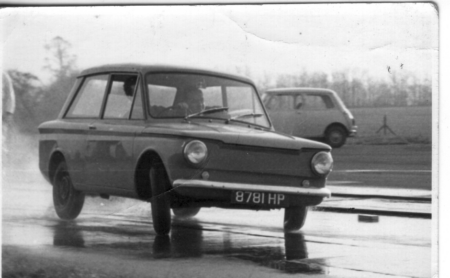Overview
A vehicle might be subjected to misuse, peak load or strength events such as driving over a curb or skidding against a curb a few times during its life. These durability load cases play a major role in the product development process since they potentially drive the design for several components. At Volvo, the “driving over a curb” and “skid against a curb” strength events are classified into two categories, Level 1 and 2. Level 1 represents extreme customer usage and the requirement is that all functions remain intact with no visible or noticeable deformation of any component of the vehicle. Level 2 covers customer misuse and a certain amount of damage is accepted with a safe failure mode. Structural deformations are acceptable but there should be no separation or breakage. For level 2 it is desirable that a predetermined inexpensively replaceable component deforms and protects neighboring components, a design principle known as chain of failure.
Challenge
The capability to perform peak load simulation with a high level of confidence is of great importance to setting the design loads for components and studying vehicle behavior in these events. Volvo uses Adams multibody dynamics software to simulate Level 1 load cases for driving over a curb and skidding against a curb. The components of interest are modeled as linear flexible bodies in Adams. This allows for linear material response for flexible bodies so this method is only valid up to small plastic strains which is a good fit for Level 1 load cases.
Physical testing of skid against a curb load case
On the other hand, Level 2 load cases involve plasticity and buckling of flexible bodies for which there has not been a way in Adams to simulate with sufficient levels of accuracy up to now. The skid against a curb load case is verified with physical testing with a known mass hitting the vehicle at a specified velocity and impact angle. These tests require prototype hardware that is expensive to build and only available later in the product development cycle. “We wanted the capability to simulate Level 2 load cases in order to be able to evaluate design of suspension components earlier in the development cycle without having to build hardware for each design alternative,” explains Anders Wirje, technical expert CAE Durability at Volvo Car Corporation.
Solution/Validation – Skid against a curb load case
MSC recently introduced the Adams-Marc co-simulation capability that makes it possible for the first time to include geometrically and materially nonlinear structural behavior in multibody dynamics simulation. Any Adams model and any Marc model can be used in co-simulation with this tool. Post processing is done separately, Adams results in Adams and Marc results in the Marc postprocessor, or using Computational Engineering International’s (CEI Inc.) EnSight post-processor which can import both Adams and Marc results.
When setting up the co-simulation model for the skid against curb load case, the Marc model contains the lower control arm and bushings connecting the LCA to the subframe whereas the rest of the half-vehicle model are included in the Adams/Car model. Due to the extreme nature of a peak load event, component modeling is absolutely critical to simulation accuracy. All components have to be described within their full range of excitation. Key components and behavior to model include:
Contacts between curb and tire and between curb and rim Elastomers, i.e. bushings Camber stiffness of the suspension Flexibility and plasticity/buckling of structural components
Adams runs a dynamics analysis while Marc runs a quasi-static analysis which means that mass and inertia of the component is not accounted for. It would also be possible to run a transient analysis in Marc that would take mass effects into account. Adams leads the co-simulation and then feeds its results to Marc. Marc interpolates the Adams results to catch up and passes the results to Adams which extrapolates them in taking the next step. The simulated event has a duration of 0.7 seconds in clock time. The communication interval is 5e-4 seconds in clock time. The total simulation time was a very reasonable 40 minutes on a Dell laptop with 16 Gigabytes of RAM and a 2.7 GHz CPU.
Results of Adams-Marc co-simulation of Level 1 skid against curb event show no buckling or plasticity
Results of Adams-Marc co-simulation of Level 2 skid against curb event shows buckling and plastic deformation, matching physical testing results
Close-up view of Adams-Marc co-simulation of Level 2 skid against curb event
Strain mapped onto lower control arm in Level 2 skid against curb event
Lateral force on front bushing based on linear elastic simulation (blue trace) and fully non-linear Marc component (red trace)
The Adams – Marc co-simulation of the Volvo S80 front suspension accurately predicted the behavior of a Level 2 skid against a curb load case. The low velocity impact (Level 1) and high velocity impact (Level 2) cases showed the same behavior as the physical tests.
Results
The ability to accurately simulate Level 2 load cases will make it possible to substantially improve the product development process. “From the early stages of the development process, we will be able to evaluate the performance of alternative designs in terms of their performance under Level 2 loads,” Wirje said. “The ability to quickly and easily look at alternatives at a time when we are not locked into any particular approach should make it possible to meet performance requirements with a lighter suspension that can improve the fuel economy of the vehicle. At the same, we should be able to reduce the cost and time involved in suspension development by performing product development more accurately from the beginning so fewer prototype verification cycles are required. Of course, full physical verification will be performed at the end of the project.”




